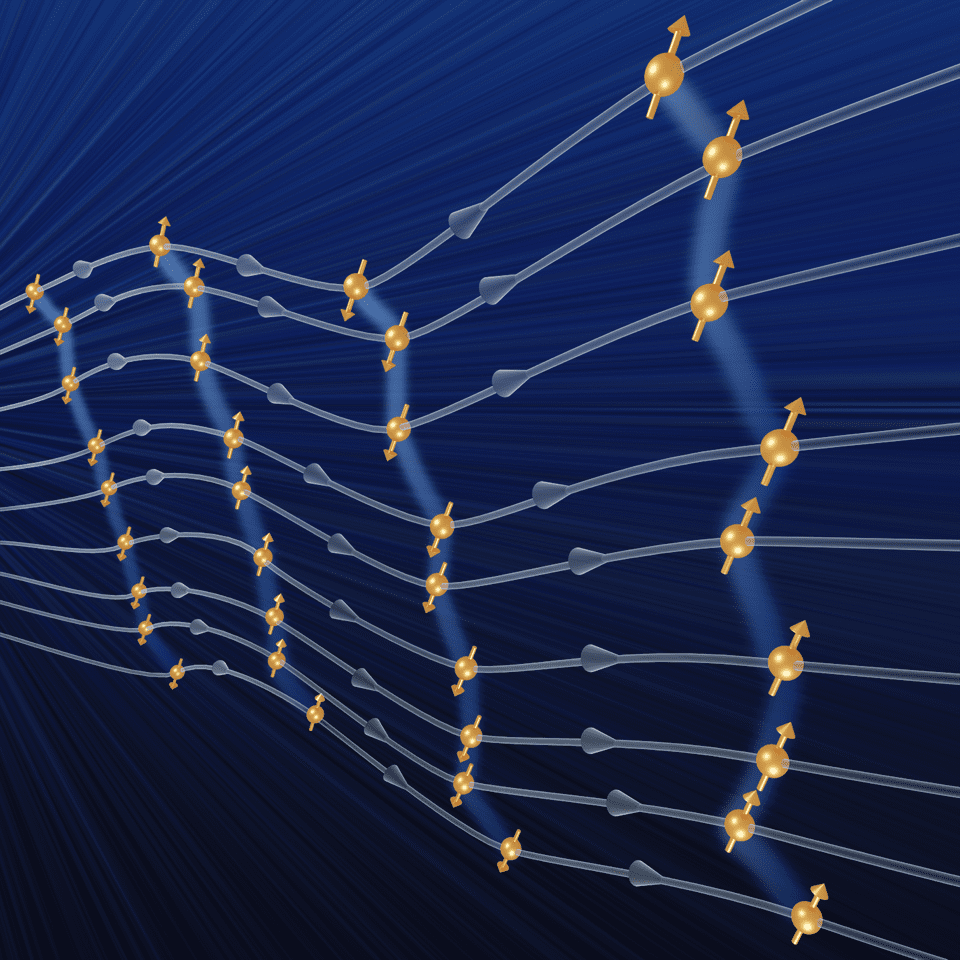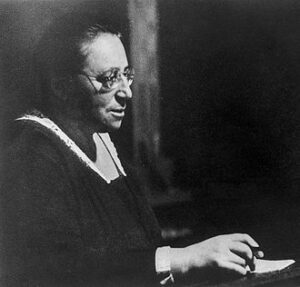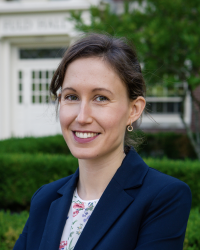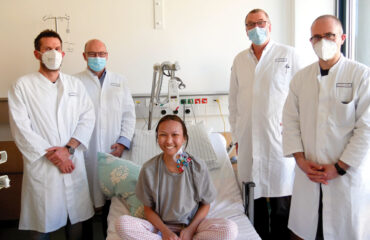
Artist’s impression of phase transitions in a discrete time crystal composed of nine carbon-13 atoms in diamond, with an arrow indicating the direction of spin of the nucleus of each atom. The atomic nuclei are locked in a chain where the orientation of their spins periodically inverts their spin phases. (Image by Joe Randall and Tim Taminiau, of QuTech , which used a quantum computer to create a Floquet time crystal in 2021 that lasted 8 seconds with periodic stimulation of energy pulses.)
By James Myers
This February, scientists at TU Dortmund University announced they had succeeded in creating a time crystal that can last for 40 minutes without added external stimulation, which is millions of times longer than earlier attempts. Researchers are beginning to seriously consider of possible uses for time crystals, because they break an important physical principle: the principle of time translation symmetry.
Breaking time translation symmetry could have profound effects on technological development, perhaps most particularly by allowing extremely accurate measurement of frequencies in materials and processes.
Measurement, as we have reported (see The Observer Effect: Why Do Our Measurements Change Quantum Outcomes?), is a significant problem in quantum mechanics since, for unknown reasons, the act of measuring a quantum state destroys the state. To appreciate the importance of the research breakthrough with a time crystal that operates for as long as 40 minutes, first we need to understand what a time crystal is.

Dr. Frank Wilczek. Image: MIT
In 2012, Nobel Prize-winning physicist Frank Wilczek proposed the possibility of creating a time crystal.
His idea was inspired by crystals like diamonds with repeating structures in space that defy the normally smooth transition of one point in space to another. Wilczek proposed an analogous type of material at the atomic scale that, instead of spatial repetitions, would exist with repeating periods in time.
The hypothetical material would switch between quantum states at regular time intervals indefinitely and, crucially, without requiring external interference and consuming energy. The effect is somewhat like a perpetual motion machine, which the second law of thermodynamics rules out in practice because of entropy which increases the disorder of a system over time. Dr. Wilczek named this theoretical quantum state-switching material a “time crystal.”
Time crystals operate between two fixed, or “localized”, states in a chain of quantum particles.
In the chain, each particle has a spin – up, down, or some probability of both – that naturally fluctuates and tends to align. Interference can cause the particles to become perfectly harmonized, locking them in a particular configuration where they are unable to settle into thermal equilibrium. Thermal equilibrium would otherwise equalize the density of the particles over the surrounding area, and breaking thermal equilibrium is called localization.
The term “localization” derives from the fact that, being out of equilibrium with its surroundings, the system operates only within a limited area – in other words, the system has a boundary that makes it “local” and not “global.”

“What looks like a flame is the measurement of the new time crystal: Each point corresponds to an experimental value, resulting in different views of the periodic dynamics of the nuclear spin polarization of the time crystal.” It might appear to the viewer as if the two poles of counter-spinning localized areas always form a triangular pattern, maintaining opposites at equal distance with a shared base and a common middle that’s neutral to both. Image: Alex Greilich/TU Dortmund University
When all the spins in a localized system are flipped, say from up to down, another localized state results. The power of a time crystal is that it can theoretically oscillate between two counter-spinning localized states infinitely, without gaining or losing energy in the passage of time. External time, for such crystal configurations, would not seem to be relevant.
In 2012, time crystals were merely a hypothesis, with no precursors in existence in the real world.
The concept was so enticing, however, that scientists raced to create time crystals. In little more than a decade, they finally achieved one that can switch between two quantum states for 40 minutes when previous attempts had operated for only milliseconds.

Dr. Alex Greilich works at the Condensed Matter research focus at TU Dortmund University. Image: TU Dortmund University
Led by Dr. Alex Greilich, the TU Dortmund University scientists created a time crystal using a compound of indium gallium arsenide in such a way that, when illuminated with electrons from a constant light source, the nuclei of the compound’s atoms form two opposite states.
In a chain reaction, the polarization of the atomic nuclei into opposites creates two localized states in the crystal. Within the crystal, one state oscillates to the opposite state at a steady frequency over time. Think of it perhaps like an incredibly accurate clock that never needs winding or adjustment.
Additionally, while earlier time crystals required boosts with pulsating frequencies of energy at periodic time intervals, and could at most double the length of that time in operation, Dr. Greilich’s team succeeded in initiating their time crystal with a constant amount of energy.
This is an exceptionally important feature because none of the ambient energy was absorbed by their crystal at the outset or during its operation. If such a crystal could continuously operate without reaching a limit that destroys its regular frequency and “melts” it, it could deliver extremely accurate measurements of time in quantum processes. Crucially, in taking time measurements without using external energy, the crystal would not disturb the measured objects and not invoke the quantum observer effect that would otherwise destroy the measured state.
Last year, in From What Is Real, to What Is Possible: The Discovery and Creation of Time Crystals, we reported that a time crystal prototype, called a Floquet time crystal, had been created in 2021. Unlike the TU Dortmund University time crystal, which continuously operates without external stimulation, a Floquet time crystal requires the periodic application of external energy to continue its oscillations. The latest generation of a time crystal, having advanced from one that requires external energy to one that operates self-sufficiently, could prove revolutionary.
What is time translation symmetry?
Time translation symmetry is the principle that the laws of physics are the same throughout history, which allows us to measure physical objects reliably over time.
Over the past century, since uncovering the fundamentally quantum nature of the universe, scientists have been seeking a reliable way to measure quantum effects over time. Obtaining an accurate quantum measurement – one that somehow defeats Heisenberg’s Uncertainty Principle – would be a monumental feat because the quantum is the tiniest amount of energy that can either cause change or be changed.
Heisenberg’s Uncertainty Principle says that we cannot simultaneously measure with equal accuracy both the position (x) of a quantum in space and its momentum in time (p). Specifically, the mathematical expression of the Uncertainty Principle, devised by Hermann Weyl, says that the uncertainty in position multiplied by the uncertainty in momentum is greater than or equal to the Planck constant divided into a circle and further divided by 2, as follows: Where:
Where:
- σ means standard deviation (average variance from the mean, which is a measurement of uncertainty);
- x is spatial position defined in 4 dimensions;
- p is momentum in time, which can also be expressed as the product of mass and velocity (p=mv);
- h is the Planck constant, which equals a photon’s energy divided by its frequency and is effectively the minimum measurement of the action of a particle of energy (the photon);
- the bar through the h means that the Planck constant is divided into a circle of 2π, so that instead of the bar it could be written as h/(π+π).
Imagine being able to measure the universe at its very quantum foundational level, and to observe the smallest components of energy (E) and mass (m) operating in Einstein’s famous equation E=mc(1+1) which also describes the largest structures in the universe like galaxies. Would it advance understanding of why the speed of light (c), which is 299,792,458 metres per second in a vacuum, is the limit of energy and mass when they combine in time?
A physical crystal like a diamond breaks spatial symmetry because of its repeating pattern, and similarly a time crystal would break time translation symmetry, which is the principle that a stable object remains the same from one time to the next.

Emmy Noether 1882-1935 (pictured c. 1930). Image: Wikipedia
Time translation symmetry is analogous to space translation symmetry.
Space translation symmetry is the reason we’re able to predict that a mountain won’t spontaneously evaporate when we move from one side to the other, and house cats won’t suddenly turn into lions when they move from one room to the next. Similarly, time translation symmetry allows us to predict that eggs won’t unscramble themselves and broken glass won’t spontaneously reassemble itself. With time translation symmetry, broken glass remains broken, and scrambled eggs remain scrambled regardless of how much time passes.
Space and time translation symmetries were invaluable discoveries of mathematician Emmy Noether, whose theorems establish that for every physical constant like the speed of light (c) or the gravitational force (G), there is a mathematical symmetry. Einstein proclaimed Noether’s brilliance, and the mathematics of symmetries have become essential in modern physics as it aims for precise measurements of the exchange of energy and mass according to Einstein’s field equations.
Since time runs only one way, in which the past does not become confused with the future, we can plan our daily activities knowing that one thing will lead to another. But if that translation symmetry is broken, and past and future can be isolated to fixed localized limits, what would we be able to do in the present – exactly in the middle? The “why” question for time crystals has perhaps not been explored as closely as the “how” question.
Why could breaking time translation symmetry revolutionize technology?
The time crystal breakthrough could be especially important in advancing the development of quantum computers, which use the quantum to transmit signals. The paper published by Dr. Greilich and co-authors states “the time crystal state enables fundamental studies of nonlinear interactions and has potential applications as a precise on-chip frequency standard.”
A significant challenge to the development of fully functioning quantum computers is the loss of quantum connections due to the interference of thermal equilibrium with the surrounding environment. This is called decoherence, and results in errors in the transmission of quantum signals. Last December, we reported on a Breakthrough in Error Correction that is advancing the potential of quantum computing, and breaking thermal equilibrium in a time crystal could lead to new methods of avoiding the problem of quantum decoherence.
It is also believed that with their incredible measurement precision, time crystals could allow identification of new and exotic states of matter beyond the familiar solid, liquid, and gas phases which are driven by heat. In a particular thermal equilibrium, such as in a gas where heat distributes throughout in a gradient from hot to cold, matter exists in a state mathematically proven to be symmetric. However, at the moment of transition from one phase to another, signs of intermediate stages are now being detected, and precise timing could reveal much about the very moment in time as one phase of matter turns into another.
The hunt for phase changes is, in fact, universal.

Dr. Isabel Garcia Garcia. Image: University of Washington
Physicists like Dr. Isabel Garcia Garcia are now searching for evidence of a fundamental phase transition in the early universe by looking for its signature in gravitational waves.
We reported on gravitational waves last August, asking Does the Universe have a Holographic Memory? and exploring possible connections to a recently-observed consistent vibrational “hum” in the universe’s gravitational wave background. The hum is comprised of consistent frequencies that are 10-12 orders of magnitude smaller than those measured by the gravitational wave detector LIGO, and have wavelengths light years long,” explained Dr. Jeff Hazboun, a lead author of one of the papers on the newly-discovered phenomenon.
The Quantum Record covered the work at LIGO, the Laser Interferometer Gravitational-Wave Observatory, in December 2022 with our article, Quest to Detect Physical Memory in Spacetime.
What lies ahead to be discovered about time’s elusive nature, whether in the realm of phase transitions in matter, or in technological applications that time crystals might enable?
What might a time crystal oscillating infinitely between two limits reveal about the present and its relationship to the past and future?
In searching for the signs of a phase transition that’s fundamental to the entire universe, Dr. Garcia Garcia examines voids in space. In our feature this March, Evolution of the Universe: Why Measuring Voids of Nothing Tells Us Something, we quoted Dr. Garcia Garcia’s words to The Joy of Why podcast host mathematician Steve Strogatz:
“In a sense, the vacuum is sort of like the starting point of any theory. It’s part of the definition of what your theory is. You define your vacuum state as the thing where nothing can be removed from it. In technical terms we sometimes say the vacuum cannot be annihilated, there’s nothing left to be removed, and on top of that you build everything else. So the properties of these vacuum states influence the properties of everything else that you’re going to build on top of it. They influence the properties of your theory at any other energy scale, so it’s sort of like the pillars of the rest of your theory that you’re going to use to describe nature.”
Will precision measurements of energy at its tiniest scale, the quantum, aid in the building of theories beginning at the vacuum, where no physical matter exists, to the greatest scales of energy and mass in galaxies? What secrets of time might be unlocked if a universally fundamental phase transition of matter is discovered?
The prospect of finding something so timeless in the middle of nothing is truly fascinating.



